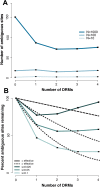On the unfounded enthusiasm for soft selective sweeps II: Examining recent evidence from humans, flies, and viruses
- PMID: 30592709
- PMCID: PMC6336318
- DOI: 10.1371/journal.pgen.1007859
On the unfounded enthusiasm for soft selective sweeps II: Examining recent evidence from humans, flies, and viruses
Abstract
Since the initial description of the genomic patterns expected under models of positive selection acting on standing genetic variation and on multiple beneficial mutations-so-called soft selective sweeps-researchers have sought to identify these patterns in natural population data. Indeed, over the past two years, large-scale data analyses have argued that soft sweeps are pervasive across organisms of very different effective population size and mutation rate-humans, Drosophila, and HIV. Yet, others have evaluated the relevance of these models to natural populations, as well as the identifiability of the models relative to other known population-level processes, arguing that soft sweeps are likely to be rare. Here, we look to reconcile these opposing results by carefully evaluating three recent studies and their underlying methodologies. Using population genetic theory, as well as extensive simulation, we find that all three examples are prone to extremely high false-positive rates, incorrectly identifying soft sweeps under both hard sweep and neutral models. Furthermore, we demonstrate that well-fit demographic histories combined with rare hard sweeps serve as the more parsimonious explanation. These findings represent a necessary response to the growing tendency of invoking parameter-heavy, assumption-laden models of pervasive positive selection, and neglecting best practices regarding the construction of proper demographic null models.
Conflict of interest statement
The authors have declared that no competing interests exist.
Figures



References
-
- Maynard Smith J, Haigh J. The hitch-hiking effect of a favourable gene. Genet Res. 1974;23: 23 - PubMed
Publication types
MeSH terms
LinkOut - more resources
Full Text Sources
Molecular Biology Databases
Miscellaneous

